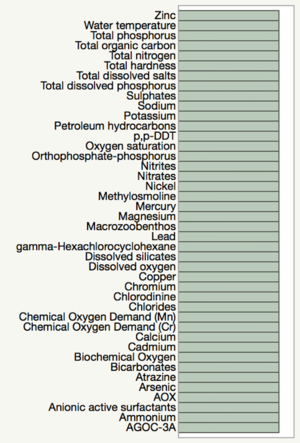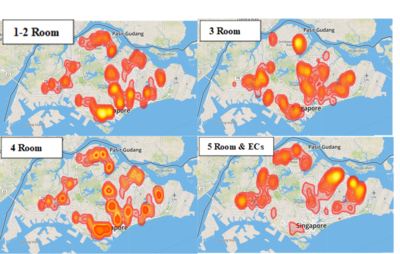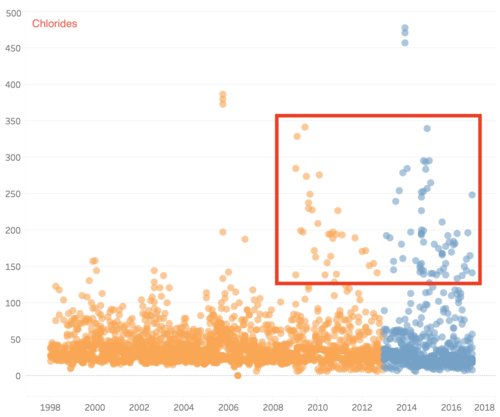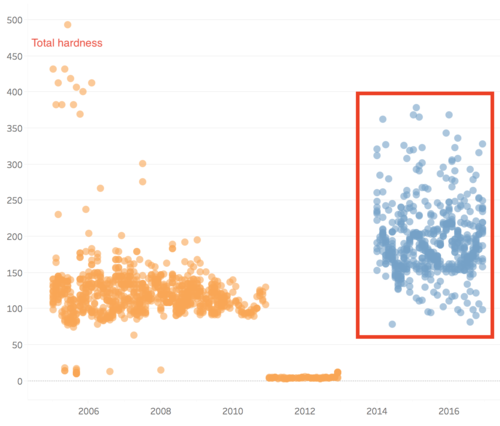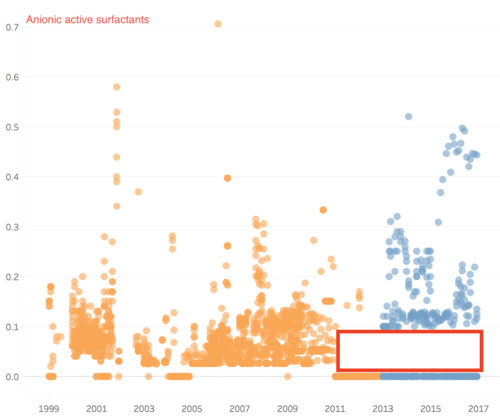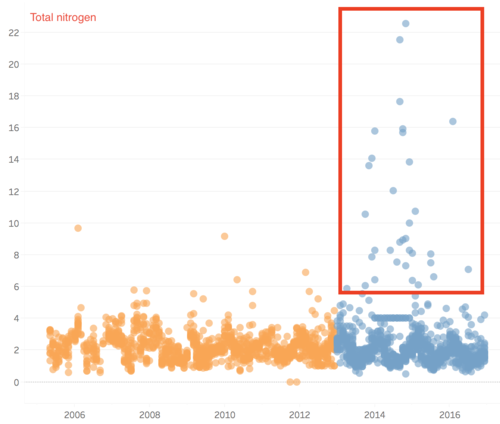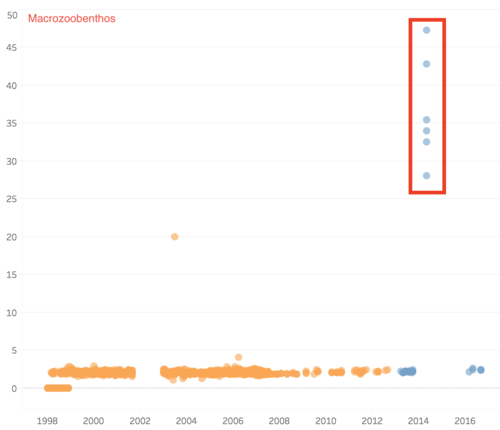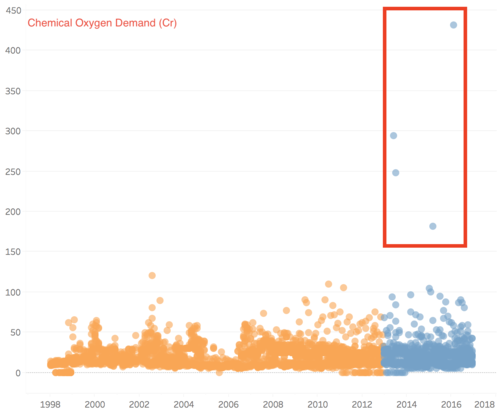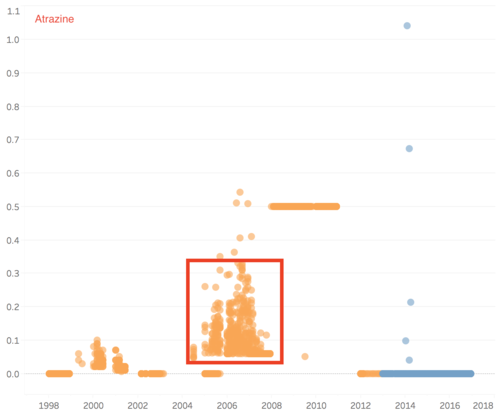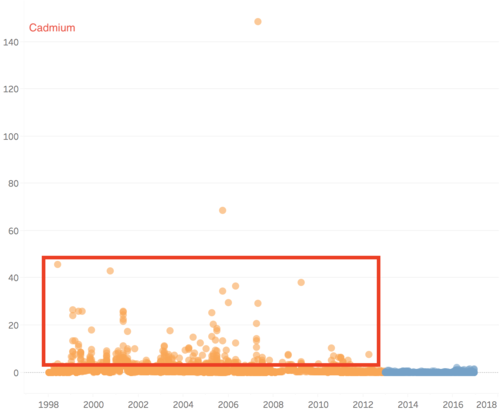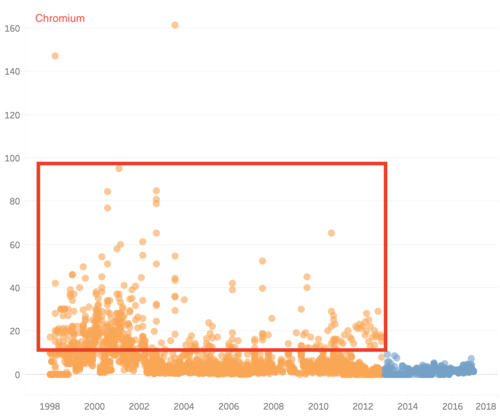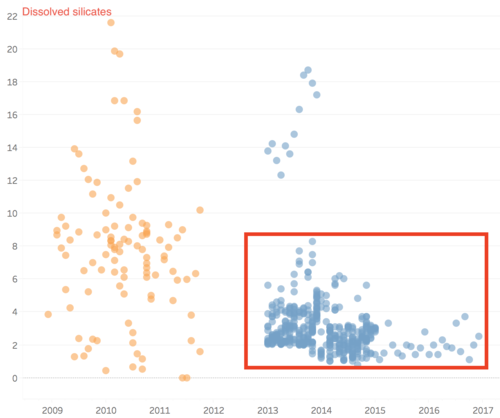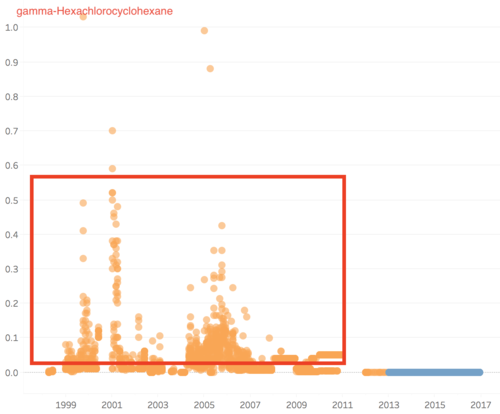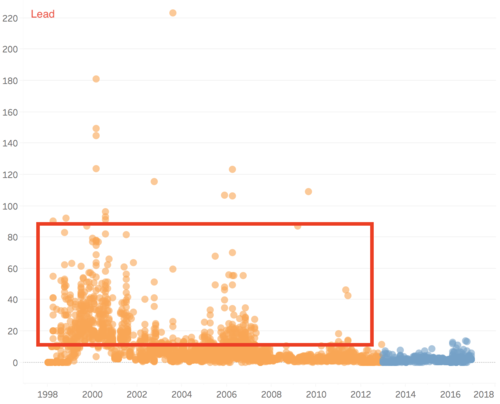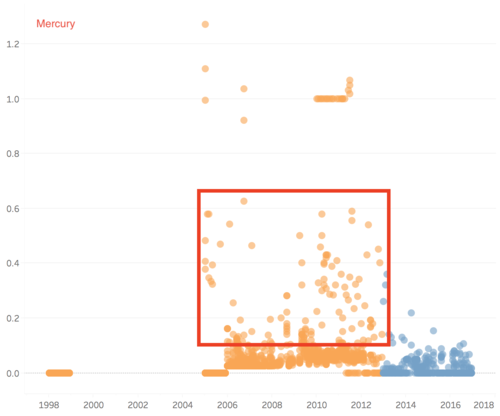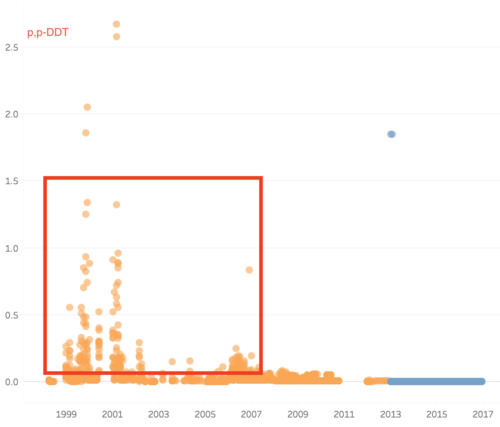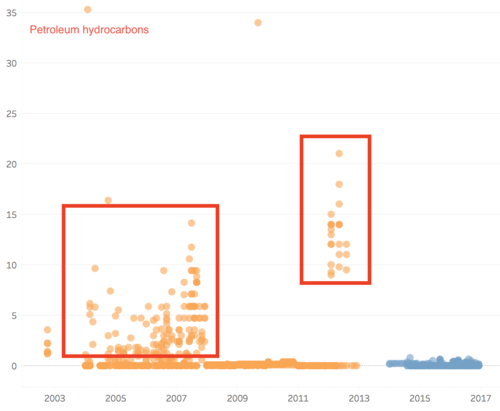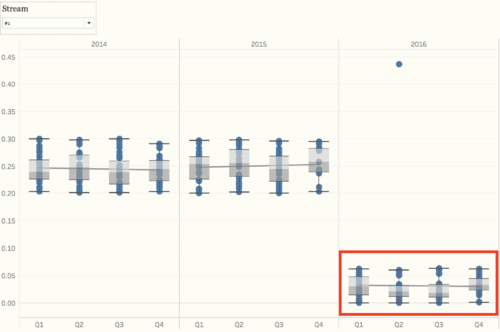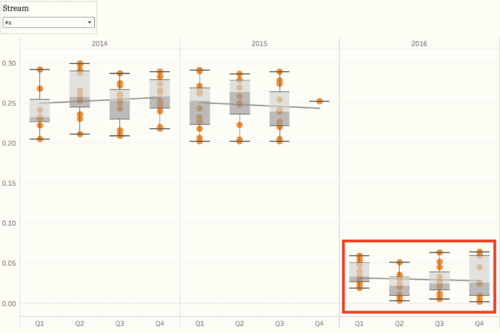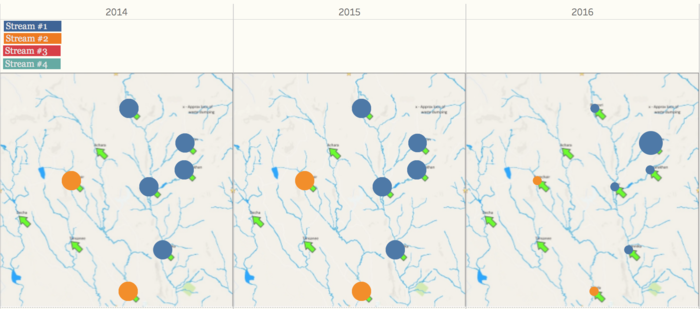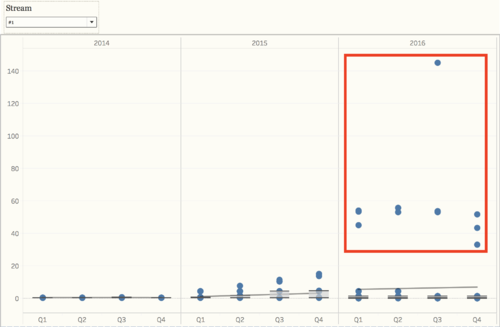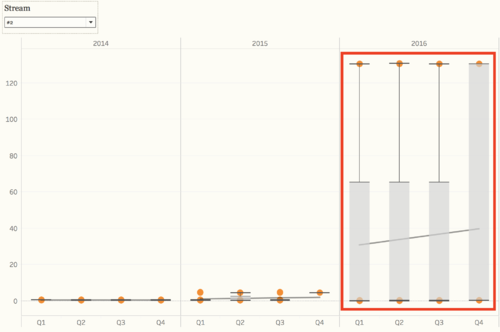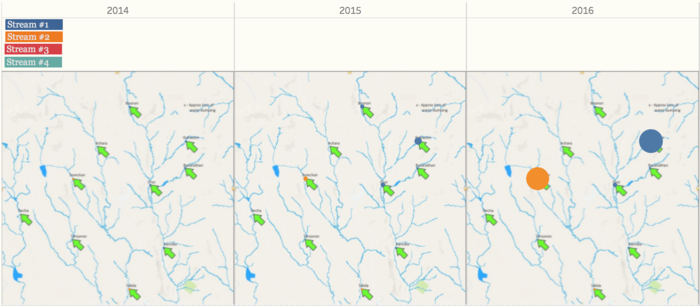Difference between revisions of "ISSS608 2017-18 T3 Assign Song Xuejing Data Preparation"
Xjsong.2017 (talk | contribs) |
Xjsong.2017 (talk | contribs) |
||
| Line 100: | Line 100: | ||
the outlier value of gamma-Hexachlorocyclohexane, Cadmium and Chromium decreased a lot, and in recent years, the value of these two chemicals is very stable. | the outlier value of gamma-Hexachlorocyclohexane, Cadmium and Chromium decreased a lot, and in recent years, the value of these two chemicals is very stable. | ||
Lindane(gamma-Hexachlorocyclohexane) has been detected in groundwater and surface water samples collected near hazardous waste sites, however, in our cases, the value is zero in recently. Therefore, to some extents, the river may also has become better. | Lindane(gamma-Hexachlorocyclohexane) has been detected in groundwater and surface water samples collected near hazardous waste sites, however, in our cases, the value is zero in recently. Therefore, to some extents, the river may also has become better. | ||
| + | </font></font> | ||
| + | |||
| + | ==<font size="5"><font color="#f75b47" face=" Georgia">'''Question 2'''</font></font>== | ||
| + | |||
| + | <font size="3.5"><font face=" Georgia" color="#000000"> | ||
| + | From the overview of all the chemical measurements, we may want to look into the details of different locations, and we can find out which location contribute to the value most, and result in the contamination of the river. | ||
| + | Because we need to find out the anomalies in the waterway, and want to find out the effects of factory dumpping sites, we only use data in recent years, to detect the anomalies of chemical measurements. | ||
| + | For chemical measurement Chlorodinine, which only have sample data points from 2014 - 2016. The distribution of it is distinguished from other chemicals. | ||
| + | Both in stream #1 and stream #2, the value in 2016 decreased to below 0.1 µg/l. | ||
| + | From the map, we can notice that the chemical value of Chai, Boonsri and Busarakhan in stream #1 was decreasing from 2014 to 2016. However, the chemical value of Kohsoom was keep increasing from 2014 - 2016. | ||
| + | In stream #2, the chemical value of both of the locations, Somchair and Sakda, was decreasing from 2014 - 2016. | ||
| + | [[Image:Chlorodinine1.png|500px|center]] | ||
| + | [[Image:Chlorodinine2.png|500px|center]] | ||
| + | [[Image:Chlorodinine3.png|700px|center]] | ||
| + | Also, there is another chemical called Methylosmoline, which only have the sample from 2014 - 2016. The value of it in stream #1 has a upper trend since the begginning of 2015, and the value stayed at around 50 µg/l in 2016. | ||
| + | In stream #2, the situation is more extreme. In 2014 and 2015, the value is relative stable around 0 µg/l, however, some of the sample points increased to 130 µg/l in 2016. Moreover, from the map, we can find out that Kohsoom from stream #1 and Somchair from stream #2 are the locations that have contribute to the high level of values. | ||
| + | [[Image:Methylosmoline1.png|500px|center]] | ||
| + | [[Image:Methylosmoline2.png|500px|center]] | ||
| + | [[Image:Methylosmoline3.png|700px|center]] | ||
</font></font> | </font></font> | ||
Revision as of 11:49, 8 July 2018
VAST Challenge 2018: Suspense at the Wildlife Preserve
Mini Challenge 2 - Like a duck to water
|
|
|
|
|
|
Data Preparation
1.1 Choosing Chemicals
We have two dataset which include the chemical units of measure and Boonsong Lekagul waterways readings. There are 106 different chemical measurements of the water, some of them are chemicals that will damage the water, which may possible output by the furniture factory, and some of the chemicals are just minerals such as iron and zinc. Also, these samples were randomly taken from 1998 to 2016. Therefore, firstly, we need to filter out all the chemicals that we need.
We should use chemicals have enough data points at least in recent years, because we need to identify that the water quality has been bad since the furniture factory has been build. If the chemical is no longer measured anymore, there is no point to identify the changes of the water quality. After first round of filtering, we have these chemicals remaining, only these chemicals have data till 2016.
1.2 Map
Since we have a map of the locations of sample points and the waterways, we need to map our sample points onto it, in order to detect the anomalies in different waterways. Use this map as background image in tableau and create the coordinates of different locations. The locations points and map are shown as below.
Also, based on the location, we separate all the location into four streams, from right to left on the map, they are 1 to 4, respectively. Because once the upstream of the river has been polluted, the downstream will be affect to some extent. Therefore, we separate the streams as below.
Question 1
After filtering out all the unnecessary chemicals, we can take a look at the overview of all the chemicals in different places one by one. For question1, we need to characterize the past and most recent situation with respect to chemical contamination in the Boonsong Lekagul waterways. Because we don’t know which year the factory was build, we define the recent as data point after 2013, and the past as data points before 2013, in order to see if there is any trend of some chemical measurements. After going through all the chemicals, we have found three apparent type of trends. First, the value of some chemicals increased from past to recent years. Including chemicals as below.
Secondly, the value of some chemicals tends to have more outliers than past few years, and these chemicals are as shown below.
Thirdly, there are even some value of chemicals decreased from past to recent years, because the samples are not just including chemical contamination, but also include some minerals. Therefore, these chemicals are as below.
In summary, chemical measurements such as Chlorides and Total hardness have increased from past years to recent years.
For Chlorides, almost all natural waters contain chloride and sulfate ions. Their concentrations vary considerably according to the mineral content of the earth in any given area. In small amounts they are not significant. In large concentrations they present problems. Usually chloride concentrations are low.
The EPA Secondary Drinking Water Regulations recommend a maximum concentration of 250 mg/1 for chloride ions and 250 mg/1 for sulfate ions (expressed as Cl- and S04--, not as CaC03).
Therefore, we can notice that the value of chloride has exceeded 20mg/l in recent year, which is not a good things, and we can dig deeper in the question 2.
For total hardness, it is actually a measurement of groundwater. The value of total hardness has increased, which means the river has a higher content of minerals.
In past years, generaly, the value of total hardness varies from 60 - 180 mg/l. However, in recent years, the value increased to 100 - 380 mg/l. According to hardness categary, if the value is more than 180mg/l, the category of water is very hard.
In group 2, there are more outliers in chemical measurements such as Anionic active surfactants, Total nitrogen, Macrozoobenthos, and Chemical Oxygen Demand (Cr).
For Anionic active surfactants, surfactants are compounds that lower the surface tension (or interfacial tension) between two liquids, between a gas and a liquid, or between a liquid and a solid. Surfactants may act as detergents, wetting agents, emulsifiers, foaming agents, and dispersants.
The value of recent years is diversity. Most of the values are zero, and some of the value are higher than 0.1. Unlike past years, there is a gap between 0 to 0.1 mg/l. Anionic surfactants represent, by volume, the most important group of surfactants used in cleaning products.
Therefore, if the value of Anionic active surfactants is mostly 0 mg/l, which means the water quality may not as good as before, because the cleaning ability of the water has become lower.
For Total nitrogen, total Nitrogen is an essential nutrient for plants and animals. However, an excess amount of nitrogen in a waterway may lead to low levels of dissolved oxygen and negatively alter various plant life and organisms. In our cases, the value of total nitrogen has more outliers since 2013.
There are three forms of nitrogen that are commonly measured in water bodies: ammonia, nitrates and nitrites. In further analysis, we can drill down to see which chemical contribute more to this measurement.
Macrozoobenthos is practically defined as the invertebrate community living in or on the sediment or hard substrates and retained on a 1 mm2 mesh sieve.
And the value of Macrozoobenthos actually in ground water is very low during these years, however, the outliers in 2014 is very different from other years.
In group 3, the value of chemical measuremens such as Atrazine, Cadmium, Chromium, Dissolved silicates, gamma-Hexachlorocyclohexane, Lead, Mercury, p,p-DDT, and Petroleum hydrocarbons have decreased from past years to recent years.
Atrazine is well tolerated by actively growing corn and sorghum, which absorb and metabolize the herbicide and thereby detoxify it. In recent years, the value of Atrazine nearly all become 0 µg/l. the outlier value of gamma-Hexachlorocyclohexane, Cadmium and Chromium decreased a lot, and in recent years, the value of these two chemicals is very stable. Lindane(gamma-Hexachlorocyclohexane) has been detected in groundwater and surface water samples collected near hazardous waste sites, however, in our cases, the value is zero in recently. Therefore, to some extents, the river may also has become better.
Question 2
From the overview of all the chemical measurements, we may want to look into the details of different locations, and we can find out which location contribute to the value most, and result in the contamination of the river. Because we need to find out the anomalies in the waterway, and want to find out the effects of factory dumpping sites, we only use data in recent years, to detect the anomalies of chemical measurements. For chemical measurement Chlorodinine, which only have sample data points from 2014 - 2016. The distribution of it is distinguished from other chemicals. Both in stream #1 and stream #2, the value in 2016 decreased to below 0.1 µg/l. From the map, we can notice that the chemical value of Chai, Boonsri and Busarakhan in stream #1 was decreasing from 2014 to 2016. However, the chemical value of Kohsoom was keep increasing from 2014 - 2016. In stream #2, the chemical value of both of the locations, Somchair and Sakda, was decreasing from 2014 - 2016.
Also, there is another chemical called Methylosmoline, which only have the sample from 2014 - 2016. The value of it in stream #1 has a upper trend since the begginning of 2015, and the value stayed at around 50 µg/l in 2016. In stream #2, the situation is more extreme. In 2014 and 2015, the value is relative stable around 0 µg/l, however, some of the sample points increased to 130 µg/l in 2016. Moreover, from the map, we can find out that Kohsoom from stream #1 and Somchair from stream #2 are the locations that have contribute to the high level of values.
